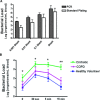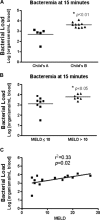Chronic liver disease impairs bacterial clearance in a human model of induced bacteremia
- PMID: 20443893
- PMCID: PMC3415466
- DOI: 10.1111/j.1752-8062.2009.00122.x
Chronic liver disease impairs bacterial clearance in a human model of induced bacteremia
Abstract
Sepsis often causes impaired hepatic function. Patients with liver disease have an increased risk of bacteremia. This is thought to be secondary to impaired reticuloendothelial system function. However, this has not been demonstrated clinically. Since transient bacteremia occurs following toothbrushing, we hypothesized that subjects with cirrhosis would have impaired bacterial clearance following toothbrushing compared with subjects with pulmonary disease and healthy controls. After baseline blood was drawn, the subjects underwent a dental examination to determine plaque index and gingival index. Following toothbrushing, blood was drawn at 30 seconds, 5 minutes, and 15 minutes. Bacteremia was measured using quantitative real-time PCR with primers that amplify all known bacteria. We found greater than 75% incidence of bacteremia following toothbrushing. While control and pulmonary subjects were able to clear this bacteremia, subjects with cirrhosis had prolonged bacteremia. Baseline and peak bacterial load correlated with plaque index, suggesting that dental hygiene predicts the degree of bacteremia. However, only the severity of cirrhosis was predictive of bacterial clearance at 15 minutes, suggesting that liver function is important in clearing bacteremia. In this study, we demonstrate clinically that cirrhosis results in impaired bacterial clearance. This suggests that cirrhotic patients may be more susceptible to sepsis because of ineffective bacterial clearance.
Figures




References
-
- Pittet D, Thievent B, Wenzel RP, Li N, Auckenthaler R, Suter PM. Bedside prediction of mortality from bacteremic sepsis. A dynamic analysis of ICU patients. Am J Respir Crit Core Med. 1996; 153(2): 684–693. - PubMed
-
- Katz S, Jimenez MA, Lehmkuhler WE, Grosfeld JL. Liver bacterial clearance following hepatic artery ligation and portacaval shunt. J Surg Res. 1991; 51(3): 267–270. - PubMed
-
- Foreman MG, Mannino DM, Moss M. Cirrhosis as a risk factor for sepsis and death: analysis of the National Hospital Discharge Suivey. Chest. 2003; 124(3): 1016–1020. - PubMed
-
- Kuo CH, Changchien CS, Yang CY, Sheen IS, Liaw YF. Bacteremia in patients with cirrhosis of the liver. Liver. 1991; 11(6): 334–339. - PubMed
Publication types
MeSH terms
Grants and funding
- R01 HL073967/HL/NHLBI NIH HHS/United States
- HL-077431-01/HL/NHLBI NIH HHS/United States
- 1TL1RR024981/RR/NCRR NIH HHS/United States
- R01 HL077431/HL/NHLBI NIH HHS/United States
- KL2 RR024980/RR/NCRR NIH HHS/United States
- K08DK073519/DK/NIDDK NIH HHS/United States
- TL1 RR024981/RR/NCRR NIH HHS/United States
- 1UL1RR024979/RR/NCRR NIH HHS/United States
- HL-073967-02/HL/NHLBI NIH HHS/United States
- K08 DK073519/DK/NIDDK NIH HHS/United States
- UL1 RR024979/RR/NCRR NIH HHS/United States
- 1KL2RR024980/RR/NCRR NIH HHS/United States
LinkOut - more resources
Full Text Sources
Medical

